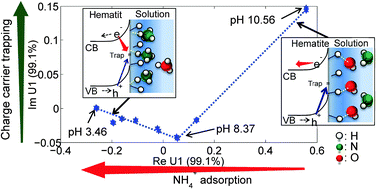Electrolyte ion adsorption and charge blocking effect at the hematite/aqueous solution interface: an electrochemical impedance study using multivariate data analysis
Abstract
A model-free multivariate analysis using singular value decomposition is employed to refine an equivalent electrical circuit model in order to probe the electrochemical properties of the hematite/water interface in dilute NaCl and NH4Cl solutions using electrochemical impedance spectroscopy. The result shows that the surface protonation is directly related to the mobility and trapping of charge carriers at the mineral surface. Moreover, the point of zero charge can be found at pH where the charge transfer resistance is the highest, in addition to the minimum double layer capacitance. The inner-sphere interaction of the NH4+ ion with the surface is indicated by an increase of capacitance for charge carrier trapping from the protonated surface as well as lower double layer capacitance and open circuit potential. It is clear that the intrinsic electrochemical activity of hematite depends on the degree of surface (de)protonation and other inner-sphere adsorption, as these processes affect the charge carrier density in the surface state. This work also highlights an important synergistic effect of the two spectral analyses that enables EIS to be utilized in an in-depth investigation of mineral/water interfaces.



 Please wait while we load your content...
Please wait while we load your content...